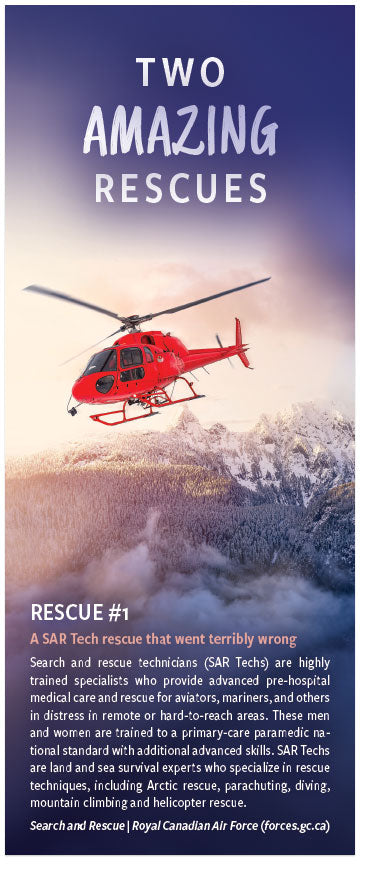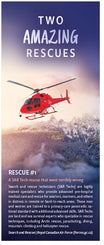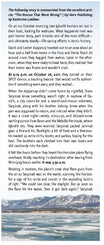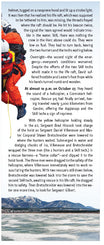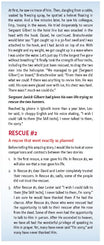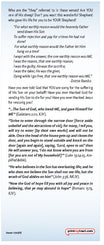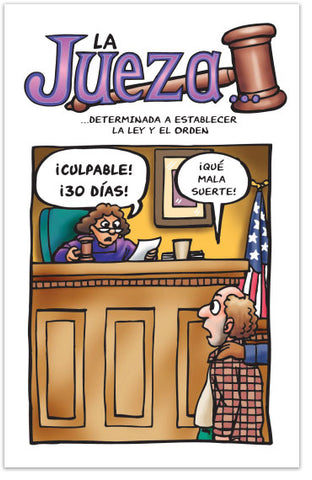Two Amazing Rescues
Special-Order Folded Flyer Tract
 NOTE: This item is custom-printed to order (click for more details).
NOTE: This item is custom-printed to order (click for more details).
This tract is from our print-on-demand library, and is not kept in stock. Select the options below, and we will custom-print a batch just for you. Because this item is custom-printed, you can add your custom imprint to the back page at no extra cost.
- Estimated shipping date: Monday, December 1 (Click for more details)
- SKU:
- Discounts: Discount coupons do not apply to this item
- Format: Folded Flyer Tract
- Size: 3.5 inches x 8.5 inches
- Pages: 8
- Imprinting: Available with 5 lines of custom text
- Returns: Because this item is custom-printed to order, it cannot be returned.
Show all item details
The full text of this flyer tract is shown below. (Do you want to print this tract in a different version than the one listed? Contact us and let us know what you're looking for—we may be able to create the alternate version for you at no charge.)
RESCUE #1
A SAR Tech rescue that went terribly wrong
Search and rescue technicians (SAR Techs) are highly trained specialists who provide advanced pre-hospital medical care and rescue for aviators, mariners, and others in distress in remote or hard-to-reach areas. These men and women are trained to a primary-care paramedic national standard with additional advanced skills. SAR Techs are land and sea survival experts who specialize in rescue techniques, including Arctic rescue, parachuting, diving, mountain climbing and helicopter rescue.
Search and Rescue | Royal Canadian Air Force (forces.gc.ca)
The following story is summarized from the excellent article: “The Rescue That Went Wrong” | Up Here Publishing by Katherine Laidlaw:
On an icy October morning, two Igloolik hunters set out in their boat, looking for walruses. What happened next was part horror story, part miracle: one of the most difficult—and ultimately deadly—life-saving efforts in Arctic history.
David and Lester Aqqiaruq traveled out to an area about an hour and a half from home in the Fury and Hecla Strait. At around noon they bagged their walrus. Later in the afternoon, when they were ready to head back, they realized that their motor was frozen and wouldn’t start.
At 9:19 p.m. on October 26, 2011, they turned on their SPOT device, a tracking beacon that would notify authorities if something went awry, and they waited…
When the Aqqiaruqs didn’t come home by nightfall, Steve Sarpinak knew something wasn’t right. A nephew of David’s, a city councilor and a search-and-rescue volunteer, Sarpinak, along with his brother Johnny, knew when the pair was supposed to return, and noticed when they didn’t. It was a cruel night—windy, minus-30, and blizzard-snow swirling across Foxe Basin and the Melville Peninsula, where Igloolik sits. They were worried. Sarpinak packed survival gear: a first-aid kit, flashlight, a bit of food and a thermos. He loaded up extra mitts, boots, and parkas, hoping for the best. The brothers each climbed into their own boats and slid cautiously into the dark.
It felt like hours before they heard the Hercules plane flying overhead, finally reaching its destination after leaving from Winnipeg hours earlier. It was 3:50 a.m.
Working in tandem, the plane’s crew shot flare guns from the air as Sarpinak was on the water, scanning the horizon for a sign of his uncle and cousin in the exploding bursts of light. “We could see clear, like daylight. But as soon as the flare hit the water, then it got dark again,” Sarpinak says. Suddenly, he spotted the pair, who looked like they were sleeping in their little 14-foot boat, stuck between ice floes not far from shore. Relief washed over him for a moment, but then frustration hit—the sheets of ice were a barricade, and his boat could go no farther. He loaded his gun and began to fire warning shots into the night, trying to wake David and Lester or send them a sign of comfort to let them know help was on its way. They didn’t wake up. Weary, Sarpinak and his brother had no choice. They turned back.
The Hercules plane dropped supplies.
At 9:52 a.m. on October 27, another Herc, Rescue 323, left Trenton, Ontario, carrying three SAR techs—master corporals Max Lahaye-Lemay and Marco Journeyman and their team leader, Sergeant Janick Gilbert. Finally, at 3 p.m., they made radio contact with Lester and his father. They learned that the hunters were growing more dehydrated and hypothermic, their hands too cold to use the supplies the last plane had provided. They dropped a life raft, which, crawling along the ice, Lester and his father were able to reach. Not long after, they watched their aluminum boat sink into the frigid sea. Soon after that, the Aqqiaruqs’ radio signal went dead.
At 3:05 p.m., the SAR techs were afraid that they had permanently lost contact with the pair; they were rapidly losing daylight and they knew there’d be no plane above them with backup for another four hours. Sergeant Gilbert and his partners made the decision: they parachuted into the water and away from all contact. They were on their own!
Let me interject here—friend, you are never alone. There is a God who loves you and cares for you.
The three techs landed in crashing waves and stunning winds. Lahaye-Lemay and Journeyman were close to the hunters. But Sergeant Gilbert landed farther away and was unable to reach them. He pulled off his helmet, tugged on a neoprene hood and lit up a strobe light. It was then that he realized his life raft, which was supposed to be tethered to him, was missing, the threads frayed where the raft should be. He hit his beacon twice, the signal the team agreed would indicate trouble in the water. Still, there was nothing the crew in the Herc above could do. They were low on fuel. They had to turn back, leaving the two hunters and the techs waiting below.
Overnight—the second night of the emergency—everyone’s conditions worsened. Despite the efforts of the two SAR techs who’d made it to the life raft, David suffered frostbite and Lester’s foot froze while his hands turned numb and wooden.
At almost 10 p.m. on October 27, they heard the sound of a helicopter; a Cormorant helicopter, Rescue 915 had finally arrived, having traveled nearly 3,000 kilometers from Gander, offering the Aqqiaruqs and the SAR techs a sign of reprieve.
With the yellow helicopter holding steady in the air, Sergeant Brad Hiscock took charge of the hoist as Sergeant Daniel Villeneuve and Master Corporal Shawn Bretschneider were lowered to where the hunters waited. Submerged in water and dodging chunks of ice, Villeneuve and Bretschneider wrapped the three men (the 2 hunters and a SAR tech.) in a rescue harness—a “horse collar”—and clipped it to the hoist hook. The three men were dragged to the safety of the helicopter, where Villeneuve immediately went to work resuscitating the hunters. With two rescuers still down below, Bretschneider was lowered back into the storm to save the second SAR tech, awaiting rescue in his life raft. He dragged him to safety. Then Bretschneider was lowered into the water one more time, to look for Sergeant Gilbert.
At first, he saw no trace of him. Then, dangling from a cable, soaked by freezing spray, he spotted a helmet floating in the water. And a few minutes later, he saw his colleague, limp, tossing in the waves. He tried desperately to secure Sergeant Gilbert to the hoist line but was smacked in the head with the hook. Dazed, he continued. Bretschneider would later say: “I got caught up in a 30-foot swell and I was attached to the hook, and I had Janick on top of me. With his weight and my weight, we got caught up in a wave where I was under the water. Let’s just say it’s the longest I’ve gone without breathing.” It finally took the strength of four techs, including the two who’d just been rescued, to drag the two men into the helicopter. “We managed to get [Sergeant Gilbert] on board,” Bretschneider said. “From there we did what we could if there was anything to revive him. He was cold. His eyes were glazed over with ice, his chest was hard. There wasn’t much we could do.”
Sergeant Janick Gilbert had given his own life trying to rescue the two hunters.
Reached by phone in Igloolik more than a year later, Lester said, in choppy English and his voice shaking, “I wish I could talk to them [the SAR techs]. I never talked to them, I’m sorry.”
RESCUE #2
A rescue that went exactly as planned
Before telling this amazing story, I would like to look at some comparisons and contrasts between the two stories:
1. In the first rescue, a man gave his life. In Rescue #2, we will also see that a man gave his life.
2. In Rescue #1, dear David and Lester completely trusted their rescuers. In Rescue #2, sadly, some of the people did not trust the rescuer.
3. After Rescue #1, dear Lester said “I wish I could talk to them [the SAR techs]. I never talked to them, I’m sorry.” I am sure he would have thanked them if he had the chance. After Rescue #2, those who were rescued had the opportunity to talk to their rescuer after He rose from the dead. Some of them even had the opportunity to talk to Him in person. After He ascended to heaven, we have all had the wonderful privilege of speaking to Him in prayer. Yet, many have never said “I’m sorry,” and many have never thanked Him.
4. Rescue #1 was planned as soon as the SAR Techs heard that the men were in trouble. Rescue #2 was planned before the world began!
“God chose Him as your ransom long before the world began” (1 Peter 1:20, NLT). And He rescued you by giving His life!
5. The dear lady that wrote about Rescue #1 (that I have summarized and quoted from) did not actually see the rescue. Katherine Laidlaw had to rely on other eye-witness accounts, yet I must say I had no trouble believing the story. Did you? There were many people who wrote about Rescue #2, some of whom were present to witness the rescue. Yet many people do not believe it!
John’s eye-witness account
John the apostle was a close friend of the Lord Jesus, and he stood by the cross while his dear friend and Saviour was crucified. These are his words:
“Then Pilate took Jesus and flogged Him. And the soldiers twisted together a crown of thorns and put it on His head and arrayed Him in a purple robe. They came up to Him, saying, ‘Hail, King of the Jews!’ and struck Him with their hands” (John 19:1-3, ESV).
The Crucifixion
“So they took Jesus, and He went out, bearing His own cross, to the place called The Place of a Skull, which in Aramaic is called Golgotha. There they crucified Him, and with Him two others, one on either side, and Jesus between them” (John 19:16-18, ESV).
“But one of the soldiers pierced His side with a spear, and immediately blood and water came out. AND HE WHO HAS SEEN HAS TESTIFIED, AND HIS TESTIMONY IS TRUE; AND HE KNOWS THAT HE IS TELLING THE TRUTH, SO THAT YOU MAY BELIEVE. For these things were done that the Scripture should be fulfilled, ‘Not one of His bones shall be broken.1’ And again another Scripture says, ‘They shall look on Him whom they pierced2’” (John 19:31-37, NKJV).
After this, Jesus was laid in a rich man’s new tomb (see John 19: 38-42), another fulfillment of prophecy. 3 And on the third day, He rose again! (See John 20.)
Why did He do it? Who did He rescue?
He did it for ME! I was the guilty one who deserved to be punished for all my disobedience to God. I deserved ETERNAL DEATH, but He died in my place! Along with what men did to Him, in three dark hours God laid on Christ unimaginable suffering for my sin!
“But He was wounded for the wrong WE did [our transgressions]; He was crushed for the evil WE did [our iniquities]. The punishment, which made US well [brought us wholeness/peace], was given to Him, and WE are healed because of His wounds [lacerations; stripes]” (Isaiah 53:5, NCV).
“For God so loved THE WORLD, that He gave His only begotten Son, that WHOSOEVER believeth in Him should not perish, but have everlasting life” (John 3:16, KJV).
“He himself bore OUR sins in His body on the tree, that WE might die to sin and live to righteousness. By His wounds YOU have been healed” (1 Peter 2:24, ESV).
(Where I have capitalized words in the previous three verses, try putting your name in, to make it personal.)
Jesus Himself said in John 10:10-11,
“I have come that they may have life, and that they may have it more abundantly. I am the Good Shepherd. The Good Shepherd gives His life for the sheep” (NKJV).
Who are the “they” referred to in these verses? Are YOU one of His sheep? Don’t you want this wonderful Shepherd who gave His life for you to be YOUR Shepherd?
“For what earthly reason would the heavenly Father send down His Son
To suffer rejection and pay for crimes He had not done?
For what earthly reason would the Father let Him hang on a tree?
I wept with the answer, the one earthly reason was ME.
I was the reason, that one earthly reason;
I was the guilty, He was the sacrifice;
I was the taker, He was the giver,
Dying while I go free, that one earthly reason was ME.”
-Dottie Rambo
Have you ever told God that YOU are sorry for the suffering of His Son on your behalf? Have you ever thanked God for sending His Son to die for you? Have you ever thanked Jesus for rescuing you?
“…The Son of God, who loved ME, and gave Himself for ME” (Galatians 2:20, KJV).
“Strive to enter through the narrow door [force aside unbelief and the attractions of sin]; for many, I tell you, will try to enter [by their own works] and will not be able. Once the head of the house gets up and closes the door, and you begin to stand outside and knock on the door [again and again], saying, ‘Lord, open to us!’ then He will answer you, ‘I do not know where you are from [for you are not of My household]’” (Luke 13:24-25, Amplified Bible).
“He who believes in the Son has everlasting life; and he who does not believe the Son shall not see life, but the wrath of God abides on him” (John 3:36, NKJV).
“Now the God of hope fill you with all joy and peace in believing, that ye may abound in hope” (Romans 15:13, KJV).
—————————————————————————————————
1. See the words of prophecy in Psalm 34:19-20, “The righteous person may have many troubles, but the Lord delivers him from them all; He protects all his bones, not one of them will be broken” (NIV).
2. See the words of prophecy in Zechariah 12:10, “Then they will look on Me whom they pierced” (NKJV).
3. See the words of prophecy in Isaiah 53:9, “They intended to bury Him with criminals, but He ended up in a rich man’s tomb, because He had committed no violent deeds, nor had He spoken deceitfully” (NET).

